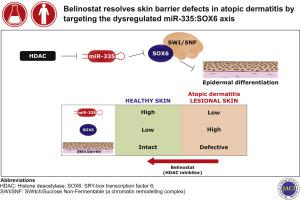Journal of Allergy and Clinical Immunology ( IF 11.4 ) Pub Date : 2020-02-21 , DOI: 10.1016/j.jaci.2020.02.007 Wen Chiy Liew 1 , Gopinath M Sundaram 2 , Shan Quah 3 , Guo Guang Lum 3 , Jonathan S L Tan 3 , Rajkumar Ramalingam 4 , John E A Common 3 , Mark B Y Tang 5 , E Birgitte Lane 3 , Steven Tien Guan Thng 6 , Prabha Sampath 7

|
Background
Atopic dermatitis (AD) is a common chronic inflammatory skin disease. Skin barrier defects contribute to disease initiation and development; however, underlying mechanisms remain elusive.
Objective
To understand the underlying cause of barrier defect, we investigated aberrant expression of specific microRNAs (miRNAs) in AD. Delineating the molecular mechanism of dysregulated miRNA network, we focused on identification of specific drugs that can modulate miRNA expression and repair the defective barrier in AD.
Methods
A screen for differentially expressed miRNAs between healthy skin and AD lesional skin resulted in the identification of miR-335 as the most consistently downregulated miRNA in AD. Using in silico prediction combined with experimental validation, we characterized downstream miR-335 targets and elucidated the molecular pathways by which this microRNA maintains epidermal homeostasis in healthy skin.
Results
miR-335 was identified as a potent inducer of keratinocyte differentiation; it exerts this effect by directly repressing SOX6. By recruiting SMARCA complex components, SOX6 suppresses epidermal differentiation and epigenetically silences critical genes involved in keratinocyte differentiation. In AD lesional skin, miR-335 expression is aberrantly lost. SOX6 is abnormally expressed throughout the epidermis, where it impairs skin barrier development. We demonstrate that miR-335 is epigenetically regulated by histone deacetylases; a screen for suitable histone deacetylase inhibitors identified belinostat as a candidate drug that can restore epidermal miR-335 expression and rescue the defective skin barrier in AD.
Conclusion
Belinostat is of clinical significance not only as a candidate drug for AD treatment, but also as a potential means of stopping the atopic march and further progression of this systemic allergic disease.
中文翻译:

Belinostat通过靶向失调的miR-335:SOX6轴来解决特应性皮炎中的皮肤屏障缺陷。
背景
特应性皮炎(AD)是一种常见的慢性炎症性皮肤病。皮肤屏障缺陷有助于疾病的发生和发展;但是,基本机制仍然难以捉摸。
目的
为了了解屏障缺陷的根本原因,我们调查了AD中特定microRNA(miRNA)的异常表达。描绘失调的miRNA网络的分子机制,我们专注于鉴定可调节miRNA表达并修复AD缺陷屏障的特定药物。
方法
通过筛选健康皮肤和AD病变皮肤之间差异表达的miRNA,可以鉴定出miR-335是AD中最一致下调的miRNA。使用计算机模拟结合实验验证,我们表征了下游miR-335靶标并阐明了该microRNA维持健康皮肤中表皮稳态的分子途径。
结果
miR-335被确定为角质形成细胞分化的有效诱导剂;它通过直接抑制SOX6发挥这种作用。通过募集SMARCA复杂成分,SOX6抑制了表皮分化,并在表观遗传上沉默了涉及角质形成细胞分化的关键基因。在AD病变皮肤中,miR-335表达异常丢失。SOX6在整个表皮中异常表达,从而损害皮肤屏障的发育。我们证明,miR-335由组蛋白脱乙酰基酶表观遗传调控。筛选合适的组蛋白脱乙酰基酶抑制剂后,确定belinostat为可恢复表皮miR-335表达并挽救AD中有缺陷的皮肤屏障的候选药物。
结论
Belinostat不仅具有作为AD治疗的候选药物的临床意义,而且还具有作为制止该系统性过敏性疾病的特应性前进和进一步发展的潜在手段。











































 京公网安备 11010802027423号
京公网安备 11010802027423号